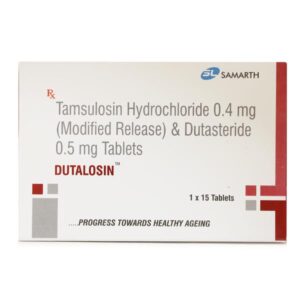DUTASETERIDE + TAMSULOSIN + HYDROCHLORIDE
Dutaseteride: Dutasteride is a medication that belongs to the class of drugs known as 5-alpha-reductase inhibitors. It is commonly sold under the brand name Avodart. Dutasteride is primarily used in the treatment of benign prostatic hyperplasia (BPH), a condition characterized by an enlarged prostate gland, which can cause urinary problems.
The mechanism of action of dutasteride involves inhibiting the enzyme 5-alpha-reductase. This enzyme is responsible for converting testosterone into dihydrotestosterone (DHT), a hormone that contributes to prostate enlargement. By blocking the action of this enzyme, dutasteride reduces the levels of DHT in the body, thereby shrinking the prostate gland and alleviating the symptoms of BPH.
The usual recommended dose of dutasteride for BPH is 0.5 mg once daily. It is typically taken orally with or without food. It may take several months of continuous use to see the full benefits of the medication, so it is important to continue taking it as prescribed.
Like any medication, dutasteride can cause side effects. The most commonly reported side effects include impotence (erectile dysfunction), decreased sex drive, ejaculation disorders, breast tenderness or enlargement, and dizziness. These side effects are usually mild and temporary, but if they persist or worsen, it is advisable to consult a healthcare professional.
It is worth noting that dutasteride may also increase the risk of developing high-grade prostate cancer. Therefore, it is important to discuss the potential risks and benefits of dutasteride with a healthcare provider before starting treatment.
Additionally, dutasteride should not be handled by women who are pregnant or planning to become pregnant, as it can be absorbed through the skin and may harm the developing fetus.
Tamsulosin: Tamsulosin is a medication commonly prescribed for the treatment of symptoms of an enlarged prostate, also known as benign prostatic hyperplasia (BPH). It belongs to a class of drugs called alpha-1 blockers.
The main mechanism of action of tamsulosin is to relax the smooth muscles in the prostate and bladder neck. By doing so, it improves the flow of urine and reduces the symptoms associated with BPH, such as difficulty in urination, weak urine flow, frequent urination, and the urgent need to urinate.
The typical starting dose of tamsulosin is 0.4 mg once daily. It is usually taken orally, with or without food. The dosage may be adjusted based on the individual’s response and tolerability. It is important to follow the instructions provided by the healthcare professional and not exceed the prescribed dose.
Like any medication, tamsulosin can have side effects. The most common side effects include dizziness, headache, abnormal ejaculation (such as decreased semen volume), stuffy or runny nose, and drowsiness. These side effects are usually mild and temporary. However, it is important to inform the healthcare provider if any severe or persistent side effects occur, such as chest pain, fainting, or allergic reactions.
Tamsulosin may interact with other medications, so it is important to inform the healthcare provider of all current medications, including over-the-counter drugs and supplements, before starting tamsulosin.
Overall, tamsulosin is an effective drug for managing the symptoms of an enlarged prostate. It works by relaxing the muscles in the prostate and bladder neck, improving urine flow and alleviating the symptoms of BPH. It is important to follow the prescribed dose and inform the healthcare provider of any side effects experienced during treatment.
Hydrochloride: Hydrochloride is not a specific drug but rather refers to the hydrochloride salt form of a drug. Many drugs are in the hydrochloride salt form, as it helps improve their stability and solubility. Therefore, it is important to specify the actual drug to provide accurate information.
For example, one commonly used drug in the hydrochloride salt form is amphetamine hydrochloride, which is used to treat attention deficit hyperactivity disorder (ADHD) and narcolepsy. The mechanism of action of amphetamine hydrochloride involves increasing the levels of certain neurotransmitters, such as dopamine and norepinephrine, in the brain. This helps to improve focus, attention, and impulse control in individuals with ADHD.
The dose of amphetamine hydrochloride depends on various factors such as age, weight, and the condition being treated. It is usually taken orally and the dosage should be determined by a healthcare professional.
Some common side effects of amphetamine hydrochloride include increased heart rate, elevated blood pressure, insomnia, dry mouth, headaches, and decreased appetite. It can also cause mood changes, anxiety, and in rare cases, serious cardiovascular effects. Like any medication, it is important to use amphetamine hydrochloride under the guidance of a healthcare professional and to report any side effects experienced.
It is important to note that this description applies specifically to amphetamine hydrochloride and not to other drugs that may also have a hydrochloride form. It is always important to consult a healthcare professional or read the drug label for accurate information about a specific drug.

